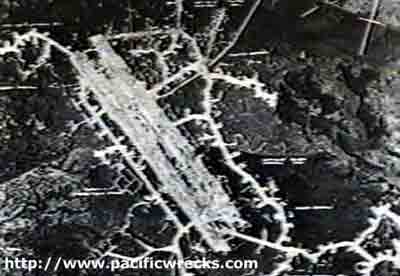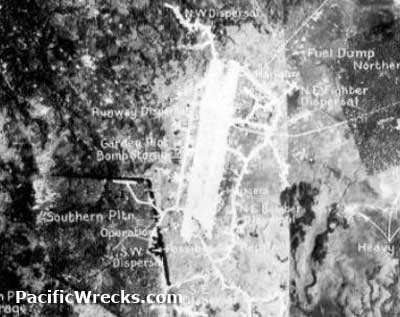|
|
|
|
| Missing In Action (MIA) | Prisoners Of War (POW) | Unexploded Ordnance (UXO) |
| Chronology | Locations | Aircraft | Ships | Submit Info | How You Can Help | Donate |
|
 43rd BG January 5, 1943  5th AF c1943  5th AF c1943  8th PRS May 1943  September 11, 1943  345th BG Oct 12, 1943  RNZAF September 1945   Justin Taylan 2000   Justin Taylan 2006 |
Location Lat 152° 8' Long 4° 19' Vunakanau Airfield was located at Vunakanau on the Gazelle Peninsula of New Britain. To the northeast approximately ten miles away is Rabaul. Known as "Vunakanau Drome". Known to the Japanese as "Rabaul West", "West Airfield, West Field, "Rabaul Upper Airfield" or "Rabaul No. 2". Between 1884 until September 1914 part of Deutsch Neu Guinea (German New Guinea). Prewar and during the Pacific War part of the Territory of New Guinea. Today located in East New Britain Province in Papua New Guinea (PNG). Construction Built prewar by the Australian administration as a single unpaved runway with a single building. Wartime History During December 1941, Vunakanau Airfield was used by the Royal Australian Air Force (RAAF) by No. 24 Squadron equipped with ten Wirraways and four Hudsons with some planes operating from nearby Lakunai Airfield. These aircraft were planes available to defend the Rabaul area. Australian units based at Vunakanau No. 24 Squadron (10 x Wirraway, 4 x Hudson) Garbutt Field arrives December 1941–January 22, 1942 withdraws On January 6, 1942 Japanese flying boats bomb Vunakanau Airfield for the first time with several other raids afterwards. On January 20, 1942 eight Wirraways from No. 24 Squadron scramble to intercept over a hundred Japanese aircraft striking Rabaul. Intercepted by escorting A6M2 Zeros and within seven minutes all were shot down or damaged and written off afterwards. On January 21, 1942 before withdrawing No. 24 Squadron commanding officer (C. O.) Squadron Leader John M. Lerew, sent the radio message "Nos Morituri Te Salutamus". Latin: "We who are about to die salute you" to RAAF headquarters at Melbourne. On January 22, 1942 the last Hudson loaded with wounded took off from Vunakanau bound for Port Moresby. Afterwards, Vunakanau Airfield was abandoned with Australian personnel trekking southward towards the southern coast of New Britain. Several damaged Wirraway were abandoned in the vicinity including Wirraway A20-319. Japanese missions against Vunakanau Airfield January 6, 1942–January 20, 1942 During late January 1942, Vunakanau Airfield was occupied by the Japanese after capturing the Rabaul area. Immediately, the Imperial Japanese Navy (IJN) began to repair and expand the runway for use as a base for bombers and fighters. During the Japanese occupation, expanded and improved by the Japanese. As of November 10, 1943 Vunakanau Airfield had two parallel runways 5,100' in length with taxiways and revetments on both sides, including 64 bomber and 81 fighter revetments. Allied intelligence noted defenses including 15 heavy anti-aircraft guns, 14 medium anti-aircraft guns and 12 light machine guns plus three searchlight batteries. Between February 14, 1942 until February 17, 1942 Type 1 / G4M1 Betty bombers from the 4th Kōkūtai (4th Air Group) arrived as the first Japanese bombers based at Vunakanau Airfield. Imperial Japanese Navy (IJN) units based at Vunakanau 4th Kōkūtai (G4M1) Feb 14-18, 1942 - ? Misawa Kōkūtai (9 x G4M1) Aug 7, 1942 - Oct 1942 705 Kōkūtai (G4M1 formerly Misawa) Jan 1943 - April 1943 702 Kōkūtai (G4M1 Betty) Kisarazu via Tinian arrives early May 1943–December 11, 1943 disbands 751 Kōkūtai (G4M Betty) October 11, 1942–May 1943 Tainan Kōkūtai (A6M Zero) April 1942 also Lakunai–November 1942 251 Kōkūtai (A6M Zero / J1N1 Irving) November 1942–middle 1943 Japanese Army Air Force (JAAF) units based at Vunakanau 1st Hiko Sentai (Ki-43 Oscar) January - August 1943 South Seas "Yo" 11073 Unit Tokusetsu Kogekitai Truk arrives February 1943–May 1943 disbanded 11th Hiko Sentai (Ki-43 Oscar) Truk arrives December 18, 1942–June 1943 departs Wewak 13th Hiko Sentai (Ki-45 Nick) arrives May 1943–September 1943 68th Hiko Sentai (Ki-61 Tony) arrives April 1943–July 1943 departs Wewak 78th Hiko Sentai (Ki-61 Tony) arrives June 1943–July 1943 departs Wewak In late January 1942, Allied aircraft began bombing Vunakanau Airfield targeting the runway and parked aircraft. By late 1943, Vunakanau Airfield was within range of Allied fighters that began escorting bombers. Despite heavy bombing, the Japanese managed to keep the runway serviceable until the end of the Pacific War. Allied missions against Vunakanau Airfield January 22, 1942–June 16, 1944 Starting on February 20, 1944 at dawn the last flyable aircraft at Vunakanau Airfield were withdrawn northward to Truk. By February 25, 1944 the withdrawal was completed and this date effectively marked the end of the air war over Rabaul. Afterwards, anti-aircraft defenses remained active in the vicinity and continued to fire at Allied aircraft. Afterwards, several Japanese aircraft left at Vunakanau Airfield were repaired to flyable status and assigned to the 105th Naval Base Air Unit and became part of the so called "Rabaul Air Force" that remained operational and continued to fly reconnaissance and a limited number of strike missions. In late 1944, Royal New Zealand Air Force (RNZAF) and Royal Australian Air Force (RAAF) aircraft continued to fly combat missions against Vunakanau Airfield until the end of the Pacific War. In early September 1945 after the official surrender of Japan, the remaining flyable Japanese aircraft were painted in surrender markings: l white with green crosses and assembled in the open at Vunakanau Airfield. The Japanese requested permission to surrender the flyable aircraft to the nearest Air Force. A RNZAF photographer documented the wreckage of several aircraft at Vunakanau Airfield including J1N1 Gekko (Irving) and B5N2 Kanko (Kate) Tail 323-352. On September 18, 1945 four Japanese aircraft painted in surrender markings (white with green crosses) took off from Vunakanau Airfield including Ki-46-II Dinah 2783, A6M5 Zero 4043, A6M5 Zero 4379 and A6M5 Zero 4444 each piloted by a Japanese pilots and flew to Jacquinot Bay Airfield. During the flight, they were escorted by Royal New Zealand Air Force (RNZAF) Corsairs. After landing, the pilots saluted made a report and were flown aboard a RNZAF PBY Catalina back to Rabaul where they became Japanese Prisoners Of War (POW). Postwar Vunakanau Airfield was repaired and continued to be used as an airport. Until 1983, one of the two former runways remained in use until Tokua Airfield was completed. Since then, both runways are disused. Today The the former runways are overgrown but still visible. Today, walking trails and roads follow the former runway and taxiways. During the 1980s, much of the remaining wreckage was transported to the Kokopo Museum for display. Catholic Mission During the 1970s, behind the Catholic Mission at Malmaluan was discovered an underground radio bunker with radios racks. A6M? Zero Tail Number 322 Tail section with tail number 322. Ki-43-I Oscar Manufacture Number 750 Located November 1945, captured as war prize CAC Wirraway Located in the vicinity, recovered to the Kokopo Museum References WW2 Nominal Roll - John M. Lerew Memories Of New Guinea by Harry Morris Contribute
Information Last Updated
|
Map May 24, 1943 View in Google Earth Photo Archive |
| Discussion Forum | Daily Updates | Reviews | Museums | Interviews & Oral Histories |
|